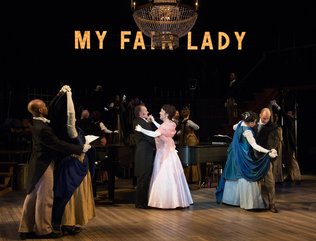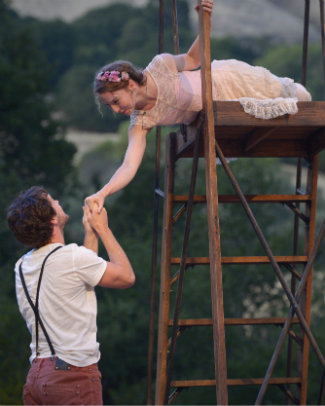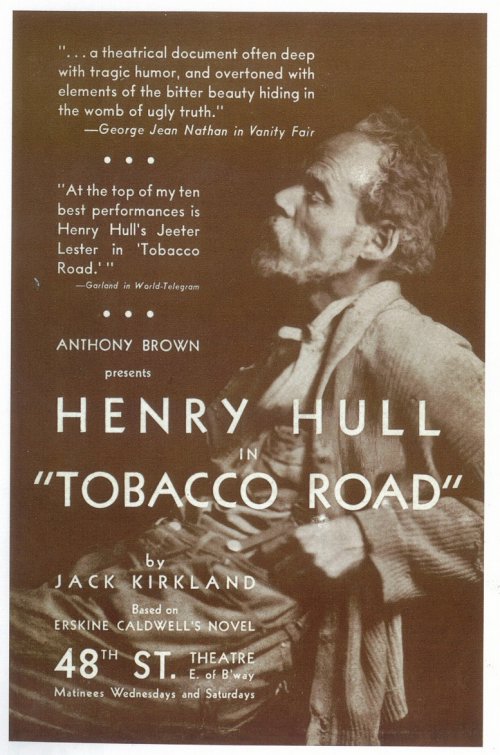In today’s Wall Street Journal drama column I review two unconventional West Coast festival productions of a pair of well-loved classics, the Oregon Shakespeare Festival’s My Fair Lady and California Shakespeare Theater’s Romeo and Juliet. Here’s an excerpt.
* * *
 Small-scale revivals of big Broadway musicals are hot nowadays. Not only are they cheaper to produce, but they allow smart directors to use their creativity to the fullest. Some of their ideas make better conceptual sense than others, however, and I had a twinge of doubt when I heard that the Oregon Shakespeare Festival had invited Amanda Dehnert to mount a miniature “My Fair Lady.” Of all the great musicals of the postwar era, “My Fair Lady” is the one that most closely resembles an old-fashioned operetta, and the spare-no-expense décor of both the 1956 Broadway production and the 1964 screen version have come to be seen as integral to its total effect. All the more reason, then, to cheer Ms. Dehnert, who has successfully wrought a radical transformation on the familiar parable of Henry Higgins (Jonathan Haugen), the haughty professor of phonetics, and Eliza Doolittle (Rachael Warren), the blunt-tongued Cockney flower girl whom he turns into a lady. She’s staged the whole thing in the style of Bertolt Brecht–and it works.
Small-scale revivals of big Broadway musicals are hot nowadays. Not only are they cheaper to produce, but they allow smart directors to use their creativity to the fullest. Some of their ideas make better conceptual sense than others, however, and I had a twinge of doubt when I heard that the Oregon Shakespeare Festival had invited Amanda Dehnert to mount a miniature “My Fair Lady.” Of all the great musicals of the postwar era, “My Fair Lady” is the one that most closely resembles an old-fashioned operetta, and the spare-no-expense décor of both the 1956 Broadway production and the 1964 screen version have come to be seen as integral to its total effect. All the more reason, then, to cheer Ms. Dehnert, who has successfully wrought a radical transformation on the familiar parable of Henry Higgins (Jonathan Haugen), the haughty professor of phonetics, and Eliza Doolittle (Rachael Warren), the blunt-tongued Cockney flower girl whom he turns into a lady. She’s staged the whole thing in the style of Bertolt Brecht–and it works.
In this visually austere production, which Ms. Dehnert created in 2000 for the Trinity Repertory Company in Providence, R.I., and has since remounted in Cleveland and Louisville, the first thing you see when you enter the theater is a pair of grand pianos at center stage. Behind them are two tiers of bleacher-style seats, with staircases on either side. The result is a compact playing area that looks rather like an Edwardian rehearsal hall, an impression strengthened when the action gets underway and the actors start changing costumes in front of the audience. But Ms. Dehnert’s production is neither a mock rehearsal nor a semi-staged concert version: It’s a presentation of “My Fair Lady,” one in which the actors seem almost to be telling the story to you rather than performing it in a 600-seat theater, eschewing elaborate props and set pieces and relying on the show itself to make its own meaning plain. The effect is not didactic but warm and intimate…
Ms. Dehnert, a one-time musician who has doubled as her own music director in addition to staging the show, makes sure that the songs are given their full expressive value (so much so that Mr. Haugen sings his numbers instead of speaking the lyrics à la Rex Harrison, a pleasing touch). As for Matt Goodrich and Ron Ochs, they play Trude Rittman’s two-piano arrangement of Loewe’s score with such blazing brio that you won’t regret the absence of a pit orchestra….
 In addition to staging “My Fair Lady” in Oregon, Amanda Dehnert was supposed to do a “Romeo and Juliet” for California Shakespeare Theater, which puts on four shows each summer in its San Francisco-area hilltop amphitheater. Illness forced her to withdraw, but Shana Cooper, Ms. Dehnert’s replacement, turns out to much more than a mere substitute. She, too, has opted for lively simplicity, giving us a clean-lined, fast-paced modern-dress “R & J” in which all of the roles are played on an open stage by a seven-person cast and Shakespeare’s star-crossed lovers (Rebekah Brockman and Dan Clegg) look as though they graduated from high school last week. The tone is boisterous–Ms. Brockman’s Juliet is zany, giggly and plainly eager to get her beau into bed–and Paul James Prendergast’s techno-pop music heightens the right-this-minute atmosphere….
In addition to staging “My Fair Lady” in Oregon, Amanda Dehnert was supposed to do a “Romeo and Juliet” for California Shakespeare Theater, which puts on four shows each summer in its San Francisco-area hilltop amphitheater. Illness forced her to withdraw, but Shana Cooper, Ms. Dehnert’s replacement, turns out to much more than a mere substitute. She, too, has opted for lively simplicity, giving us a clean-lined, fast-paced modern-dress “R & J” in which all of the roles are played on an open stage by a seven-person cast and Shakespeare’s star-crossed lovers (Rebekah Brockman and Dan Clegg) look as though they graduated from high school last week. The tone is boisterous–Ms. Brockman’s Juliet is zany, giggly and plainly eager to get her beau into bed–and Paul James Prendergast’s techno-pop music heightens the right-this-minute atmosphere….
* * *
Read the whole thing here.
Amanda Dehnert talks about her staging of My Fair Lady:
Archives for July 19, 2013
TT: Grandma’s Broadway
In today’s Wall Street Journal drama column I take a close look at a little-known list from yesterday, and see what it tells us about American theater today. Here’s an excerpt.
* * *
Two aging theater buffs strike up a conversation. Says Old-Timer No. 1: “Broadway isn’t what it used to be.” To which Old-Timer No. 2 replies, “No, and it never was.”
Who’s right? Both of them.
It’s true that Broadway has become a money-making machine chiefly devoted to the production and marketing of tourist-friendly commodity musicals. And it wasn’t always that way. Of the top 10 shows that made Entertainment Weekly’s recently published list of the best plays of the 20th century, five were premiered on Broadway between 1938 and 1962. But anyone naïve enough to believe in the existence of a golden age when Times Square was a playground for highbrows should look at a list of Broadway’s 10 longest-running straight plays….
 What do these plays have in common? To begin with, the “newest” of them opened 35 years ago. Three others date from the ’60s and ’70s. The rest are antiques. Today it’s inordinately hard for a straight play, no matter how good it is, to run on Broadway for more than a few months, since the first ingredient in the modern recipe for theatrical success is the presence in the cast of a movie or TV star. As soon as the star in question returns to Hollywood to resume his or her screen career, the show closes….
What do these plays have in common? To begin with, the “newest” of them opened 35 years ago. Three others date from the ’60s and ’70s. The rest are antiques. Today it’s inordinately hard for a straight play, no matter how good it is, to run on Broadway for more than a few months, since the first ingredient in the modern recipe for theatrical success is the presence in the cast of a movie or TV star. As soon as the star in question returns to Hollywood to resume his or her screen career, the show closes….
On the other hand, all but two of the plays on the top-10 list are light comedies of one kind or another. “Abie’s Irish Rose,” “Barefoot in the Park,” “Born Yesterday,” “Mary, Mary” and “The Voice of the Turtle” are romcoms, “Gemini,” “Harvey” and “Life With Father” domestic farces. The only exceptions are “Deathtrap,” a gimmicky whodunit by the author of “Rosemary’s Baby,” and “Tobacco Road,” the stage version of Erskine Caldwell’s once-shocking 1932 novel about the sex lives of Georgia sharecroppers. Otherwise, it appears that our great-grandparents were as partial to laughter as we are, if not more so.
Even more interesting is that most of these once-popular plays are largely forgotten today….
* * *
Read the whole thing here.
TT: Almanac
“Democracy, in fact, is always inventing class distinctions, despite its theoretical abhorrence of them.”
H.L. Mencken, Notes on Democracy
